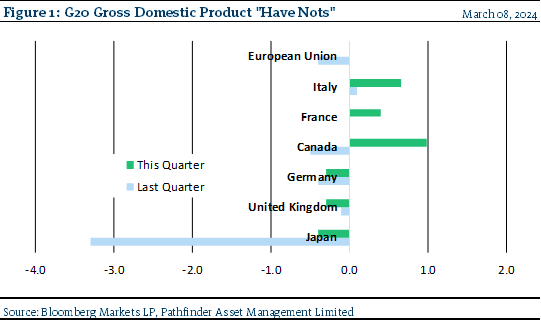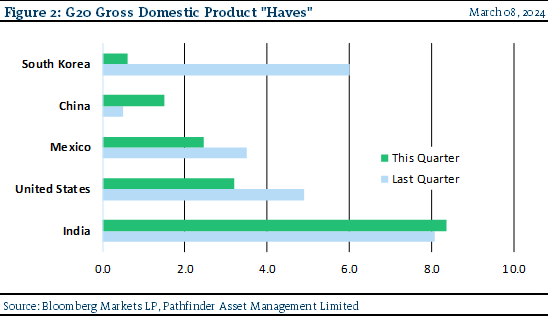Recessions...
Every morning, we have a “desk meeting” that starts with a review of various markets around the world (stocks, bonds, commodities and forex) as well as macro economic data released from the G20 nations. Before COVID, we were all in the office together, so it was easy to have a morning chat. It happened organically. During COVID, most of us started to work from home, so we created an on-line meeting basically so we could see each other. After everyone emerged from the pandemic, we kept the tradition going. We found it enjoyable and also useful to have a “touch base” each morning. A positive side benefit was that because we formally discussed the regular cadence of economic data, it allowed us to identify emerging patterns. For example, recently we noticed a good portion of the G20 drifting into technical recession or slow downs. Figures 1 and 2 present annualized GDP (for comparability, as not all countries release the data in the same format) for the past 2 quarters, which defines a technical recession.
- Figure 1 presents the “Have Nots”: Europe, the UK, Japan and Canada have drifted into technical recession or have posted weak results. Added together, this group is 18.5% of the global economy, a substantial size.

- In Figure 2, we highlight the US/Mexico block along with China and India, another huge section of the global economy (49.7%) that is effectively acting as a ballast to those economies in Figure 1. Investors should be aware of this developing trend.

“This means that” as we previously mentioned in our Annual Review (here), we continue to see significant differentiation between various global economic zones. Recent data appears to confirm this. Furthermore, we believe that the current situation is an excellent opportunity for active managers. Wider differentiation dives disconnect between market price and value. We have an opportunity to structure our funds and portfolios accordingly. This is another reason why it is critical for investors to understand what they are invested in and why.
National Instrument 31-103 requires registered firms to disclose information that a reasonable investor would expect to know, including any material conflicts with the firm or its representatives. Doug Johnson and/or Pathfinder Asset Management Limited are an insider of companies periodically mentioned in this report. Please visit www.paml.ca for full disclosures.
Changes in Leverage. We are increasing the asset ceiling to 2.0 times the market value of equity for Pathfinder International Fund and Pathfinder Conviction Fund to be consistent with Pathfinder Partners’ Fund and Pathfinder Resource Fund.
*All returns are time weighted and net of investment management fees. Returns from the Pathfinder Partners’ Fund and Partners’ Real Return Plus Fund are presented based on the masters series of each fund. The Pathfinder Core: Equity Portfolio and The Pathfinder Core: High Income Portfolio are live accounts. These are actual accounts owned by the Pathfinder Chairman (Equity) and client (High Income) which contain no legacy positions, cash flows or other Pathfinder investment mandates or products. Monthly inception dates for each fund and portfolio are as follows: Pathfinder Core: Equity Portfolio (January 2011), Pathfinder Core: High Income Portfolio (October 2012) Partners’ Fund (April 2011), Partners’ Real Return Plus Fund (April, 2013), and Partners’ Core Plus Fund (November 2014).
Pathfinder Asset Management Limited (PAML) and its affiliates may collectively beneficially own in excess of 10% of one or more classes of the issued and outstanding equity securities mentioned in this newsletter. This publication is intended only to convey information. It is not to be construed as an investment guide or as an offer or solicitation of an offer to buy or sell any of the securities mentioned in it. The author has taken all usual and reasonable precautions to determine that the information contained in this publication has been obtained from sources believed to be reliable and that the procedures used to summarize and analyze such information are based on approved practices and principles in the investment industry. However, the market forces underlying investment value are subject to sudden and dramatic changes and data availability varies from one moment to the next. Consequently, neither the author nor PAML can make any warranty as to the accuracy or completeness of information, analysis or views contained in this publication or their usefulness or suitability in any particular circumstance. You should not undertake any investment or portfolio assessment or other transaction on the basis of this publication, but should first consult your portfolio manager, who can assess all relevant particulars of any proposed investment or transaction. PAML and the author accept no liability of any kind whatsoever or any damages or losses incurred by you as a result of reliance upon or use of this publication.